Senior Projects, Fall 2015 Exhibition
The Senior Projects, Fall 2015 Exhibition opens in the main gallery at Florida Gulf Coast University on Thursday, December 3 with a reception that begins at 5 p.m. that is followed at 6 by the students’ mandatory (and dreaded) 5-minute oral presentations. The Art Gallery at FGCU is located at 10501 FGCU Boulevard on the main campus. For more information, please telephone 239-590-1000.
Following are a series of articles highlighting the projects of the art majors with work in the show.
* * * * * * * * * * * * * * * * * * * * * * * * * * * * * * * * * * * * * *
FGCU art major Kevin Watkinson uses senior project to launch digital design business (12-07-15)
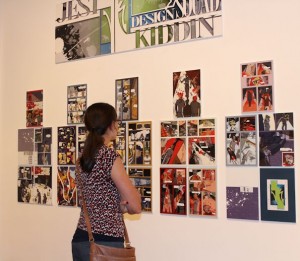 On view now through December 11 in the Art Gallery at FGCU is the Senior Projects, Fall 2015 Exhibition. It contains the capstone work of eleven graduating art majors, including that of Kevin Watkinson.
On view now through December 11 in the Art Gallery at FGCU is the Senior Projects, Fall 2015 Exhibition. It contains the capstone work of eleven graduating art majors, including that of Kevin Watkinson.
Watkinson wants to create a digital design business when he leaves school. Toward that end, Watkinson designed and executed a digital project as a trial run or paradigm, if you will, of the type of 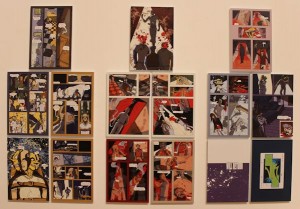 work he is capable of doing for clients on a fee-for-service basis.
work he is capable of doing for clients on a fee-for-service basis.
In this case, a close friend served as Watkinson’s ersatz and erstwhile client, with the design project consisting of creating a comic book from inception to printing.
After brainstorming for awhile, Watkinson and his 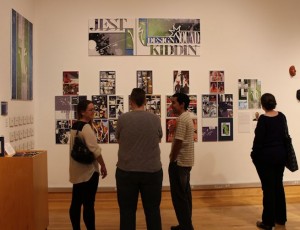 client evolved a storyline for the comic book. With that step completed, Watkinson then turned his attention to creating the artwork necessary to express the story pictorially. Employing a team concept, he had a line artist lay out sketches and ink the panels that would be used for the comic book. “I then transferred the work into Photoshop, where they became digital renders which were thoroughly colored, laid out, formatted and
client evolved a storyline for the comic book. With that step completed, Watkinson then turned his attention to creating the artwork necessary to express the story pictorially. Employing a team concept, he had a line artist lay out sketches and ink the panels that would be used for the comic book. “I then transferred the work into Photoshop, where they became digital renders which were thoroughly colored, laid out, formatted and 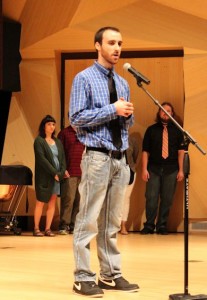 designed,” Watkinson explains in his Artist’s Statement.
designed,” Watkinson explains in his Artist’s Statement.
Photoshop is where the tweaking, fine-tuning and editing was done, and “as pages came closer to completion, bubbles were added in along with each panel’s dialog (sic).” Along with the comic book itself, Watkinson also created a business name, logo, custom fonts, posters and banners that could be used as forms of advertising by the client and his company. Thus, the final product was a turn-key effort that Watkinson hopes will attract actual paying clients in the weeks, months and years following graduation.
You can see what Kevin Watkinson accomplished as well as all the other senior projects now through December 11 in the main gallery at Florida Gulf Coast University. For more information, please telephone 239-590-7199 and to learn more about the artists and projects included in Senior Projects, Fall 2015, read on.
____________________________________________________________________
FGCU art major pays tribute to childhood friend with ‘The McGregor Tree’ (12-07-15)
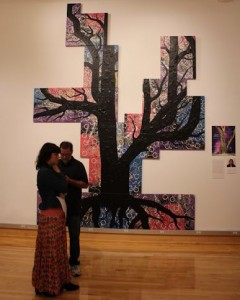 On view now through December 11 in the main art gallery at Florida Gulf Coast University is the Senior Projects, Fall 2015 Exhibition. The show includes work by eleven art majors who are graduating this semester, including Lindsey Rausch who’s work is titled The McGregor Tree.
On view now through December 11 in the main art gallery at Florida Gulf Coast University is the Senior Projects, Fall 2015 Exhibition. The show includes work by eleven art majors who are graduating this semester, including Lindsey Rausch who’s work is titled The McGregor Tree.
As a child, Lindsey and her sisters lived in a house off McGregor Boulevard and there was a giant oak tree in the family’s front yard. Lindsey recalls that the tree always stood strong, weathering hurricanes and all sorts of severe weather, including summer thunderstorms. “My sisters and I would plan our entire days around playing near the oak tree in the 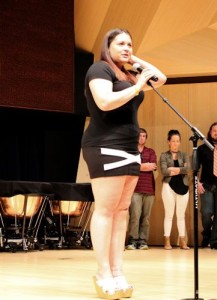 front yard,” Lindsey relates. “This is also where I met one of my first childhood friends, Wendy. She lived across the street and would come over whenever we were outside to play with us.”
front yard,” Lindsey relates. “This is also where I met one of my first childhood friends, Wendy. She lived across the street and would come over whenever we were outside to play with us.”
As little girls are wont to do, they built lemonade stands and played with their Barbie dolls under that oak. “She reminded me of our tree: she was determined; she battled her way through her own personal hurricanes and never gave up,” Lindsey reflects in her Artist’s Statement. But, Lindsey tearfully stunned the more than 250 family, friends and guests who assembled in U. Tobe hall for the seniors’ oral statements on opening night, “in August of 2014, Wendy passed away from complications with osteosarcoma.”
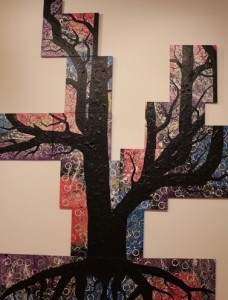 So Lindsey’s project is a homage to her friend, “a constant reminder for me to stay strong and keep fighting … if Wendy could do it, so can I.” And in order to express the depth and range of her feelings about her tree and best friend, Rausch deviated from the digital illustrations she normally creates as a graphic designer and opted for illustrative-style painting for her senior project.
So Lindsey’s project is a homage to her friend, “a constant reminder for me to stay strong and keep fighting … if Wendy could do it, so can I.” And in order to express the depth and range of her feelings about her tree and best friend, Rausch deviated from the digital illustrations she normally creates as a graphic designer and opted for illustrative-style painting for her senior project.
Rausch’s process was highly evocative. “I didn’t want to use a paintbrush for the background because I wanted to be emotionally and physically involved in the painting,” Lindsey explains. “The markings in the background needed to be 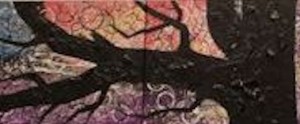 emotional markings. For the first layer on the background, I used a sponge to build up the colors in the cosmos. In the second layer, I threw and dripped paint with a paintbrush. For the third layer, I used different sizes of circles as a stamp.”
emotional markings. For the first layer on the background, I used a sponge to build up the colors in the cosmos. In the second layer, I threw and dripped paint with a paintbrush. For the third layer, I used different sizes of circles as a stamp.”
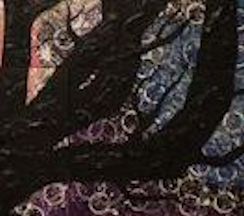 For the tree itself, Rausch used chips from dried acrylic paint tubes. “I liked the texture,” Lindsey comments. Besides, the paint chips resembled the markings in an oak tree’s bark. “I painted the background first so that whatever texture was in the background would also be in the tree as well.”
For the tree itself, Rausch used chips from dried acrylic paint tubes. “I liked the texture,” Lindsey comments. Besides, the paint chips resembled the markings in an oak tree’s bark. “I painted the background first so that whatever texture was in the background would also be in the tree as well.”
As for the scale of the McGregor Tree, Rausch painted it from floor to ceiling because she wanted viewers to be absorbed by the growth of the tree beyond the edge of the canvas. “The tree 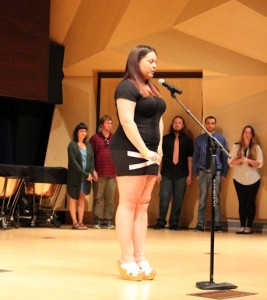 ‘grows’ off the canvas to give it a feeling of continuous life,” the artist expounds.
‘grows’ off the canvas to give it a feeling of continuous life,” the artist expounds.
She also waxes philosophically about the importance of oak trees in mythology and legend. “The ancient Celts honored oak trees as an emblem of endurance and conducted special rituals in sacred oak groves,” Lindsey advises. “In the Classical Era, Zeus and Jupiter held the oak tree sacred as the Tree of Life because its roots would penetrate deep into the underworld and its branches would soar into the sky. In northern cultures, the oak tree is believed to be the tree of the thunder gods because of 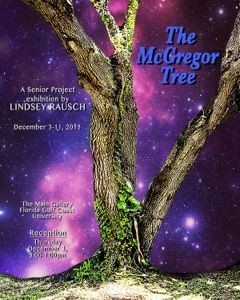 its endurance to withstand lightening strikes. Cultures in India believed that the oaks were cosmic trees called Asvattha, where the tree reverses the usual order – the roots are in the sky and the branches grow downward covering the Earth.”
its endurance to withstand lightening strikes. Cultures in India believed that the oaks were cosmic trees called Asvattha, where the tree reverses the usual order – the roots are in the sky and the branches grow downward covering the Earth.”
For Lindsey Rausch, The McGregor Tree will forever be not only a tribute to and reminder of her childhood friend, Wendy, but a symbol of strength and resilience that grows at the center of her universe. You can experience this and the rest of the art projects of this semester’s graduating art majors in the Art Gallery at FGCU now through Friday, December 11.
______________________________________________________________________________
FGCU art major Alyssa Baladad expresses trepidation about growing up and moving on (12-04-15)
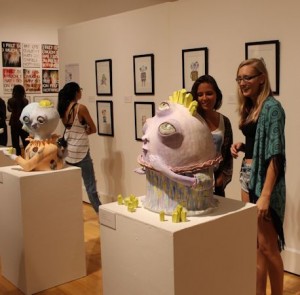 The Senior Projects, Fall 2015 Exhibition opened last night in the main art gallery at Florida Gulf Coast University. Among the eleven graduating art majors with work in the show is Alyssa Baladad.
The Senior Projects, Fall 2015 Exhibition opened last night in the main art gallery at Florida Gulf Coast University. Among the eleven graduating art majors with work in the show is Alyssa Baladad.
Like her classmates, Alyssa is facing the prospect of finding a job, launching a career and being the adult in the room among her peers. To explore the transition from childhood to adulthood, she created a series of imaginery creatures to illustrate the various levels of emotional development and attitudes towards growing up. 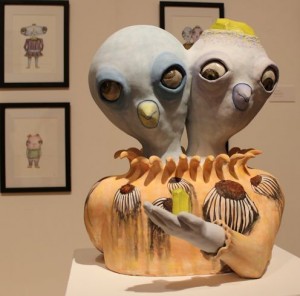 “All throughout your childhood and youth you get to test out different versions of yourself, and I think that leads into how you turn out as an adult,” Baladad observes in her Artist’s Statement. “The creatures that I have made are a way to see how you are handling, or have handled, your own transformation from adolescent to adult.”
“All throughout your childhood and youth you get to test out different versions of yourself, and I think that leads into how you turn out as an adult,” Baladad observes in her Artist’s Statement. “The creatures that I have made are a way to see how you are handling, or have handled, your own transformation from adolescent to adult.”
Baladad’s creatures are whimsical, if not downright silly. That’s by intent. “There is a sense of humor with these very silly and childlike 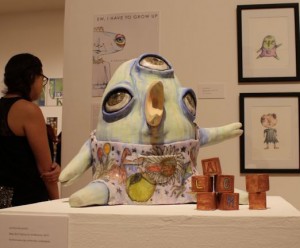 creatures I have created, but it is humor that can get us through the hardest times in our lives.
creatures I have created, but it is humor that can get us through the hardest times in our lives.
The pieces in Ew, I Have to Grow Up consist of a number of watercolors and three pedestaled painted clay sculptures. Baladad did sketchbook studies before redrawing each one on watercolor paper using a Micron pen. “Once the drawing is completed, the watercolor painting is built up through many layers of thin color,” Alyssa shares.
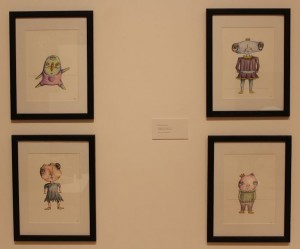 The ceramic figures were crafted from red earthenware clay using coil construction combined with sculpting and modeling techniques. Alyssa added a layer of white slip to the unfired surface to create a white canvas, and then used various carving tools to draw images onto the figure before bisque firing the finished piece in an electric kiln to 1728 degrees. “The drawings are inlaid with black glaze, finished with a unique underglaze treatment
The ceramic figures were crafted from red earthenware clay using coil construction combined with sculpting and modeling techniques. Alyssa added a layer of white slip to the unfired surface to create a white canvas, and then used various carving tools to draw images onto the figure before bisque firing the finished piece in an electric kiln to 1728 degrees. “The drawings are inlaid with black glaze, finished with a unique underglaze treatment 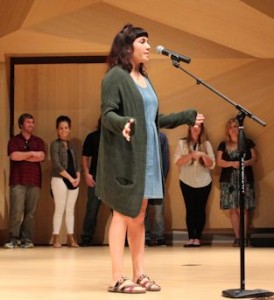 that resembles watercolor, and fired in an electric kiln once more to 1888 degrees,” Alyssa reports. “By combining 2D and 3D images, I am literally (sic) combining my childhood with my adulthood for a series that explores that space between.”
that resembles watercolor, and fired in an electric kiln once more to 1888 degrees,” Alyssa reports. “By combining 2D and 3D images, I am literally (sic) combining my childhood with my adulthood for a series that explores that space between.”
The result is as through-provoking as it is aesthetically intriguing. Come see for yourself. Ew, I Have to Grow Up and the senior projects of the entire class of graduating art majors is on view in the main gallery through December 11. Read above and below for the details on the other exhibits in this strong and sophisticated show.
___________________________________________________________________________________________
‘Senior Projects’ exhibition filled with strong, sophisticated work by next generation of FGCU art grads (12-03-15)
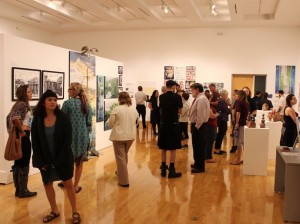 Senior Projects, Fall 2015 opened tonight in the Art Gallery at Florida Gulf Coast University. It it contains the work of graduating seniors Alyssa Baladad, Alyssa Bates, Richard Crum, Pamela Davis, Leo Navarro, Jr., Jessica Neumann, Lindsey Rausch, April Rodmyre, Adam Snell, Kevin Watkinson and Allison Witmer. Each of these FGCU art majors generated a smart,
Senior Projects, Fall 2015 opened tonight in the Art Gallery at Florida Gulf Coast University. It it contains the work of graduating seniors Alyssa Baladad, Alyssa Bates, Richard Crum, Pamela Davis, Leo Navarro, Jr., Jessica Neumann, Lindsey Rausch, April Rodmyre, Adam Snell, Kevin Watkinson and Allison Witmer. Each of these FGCU art majors generated a smart, 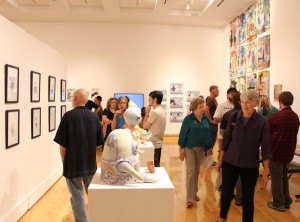 sophisticated body of self-generated work that combines their knowledge of technique and concepts to comment on the issues of today as seen through their eyes and minds. This is a worthy and worthwile group show deserving of your time and consideration. But time is of the essence here because the exhibition only runs through December 11, 2015.
sophisticated body of self-generated work that combines their knowledge of technique and concepts to comment on the issues of today as seen through their eyes and minds. This is a worthy and worthwile group show deserving of your time and consideration. But time is of the essence here because the exhibition only runs through December 11, 2015.
______________________________________________________________
FGCU art major Allison Witmer creates children’s book to draw attention to creatures facing mass extinction (12-02-15)
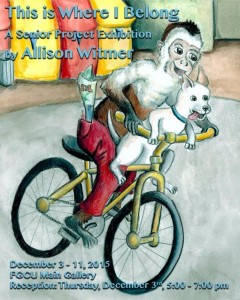 Senior Projects, Fall 2015 opens on Thursday, December 3 inside the main gallery at Florida Gulf Coast University. The exhibition contains the work of eleven graduating art majors, including that of Allison Witmer.
Senior Projects, Fall 2015 opens on Thursday, December 3 inside the main gallery at Florida Gulf Coast University. The exhibition contains the work of eleven graduating art majors, including that of Allison Witmer.
For her senior project, Witmer conceived, wrote and illustrated a whimsical children’s book that she titled This is Where I Belong. Intended for children four to seven years of age, the illustrations are bright and visually engaging and the text is simple and easy to follow for early readers. The story follows a chichuahua by the name of Tito who gets lost while his family is on vacation. On his quest to find his way back home, Tito 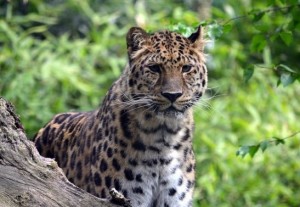 encounters four endangered creatures who also need his help to get back to where they belong. “I am sending the message that animals belong in their natural habitat – not in zoos, circuses or exotic pet shops,” Witmer states in her Artist’s Statement. “It is my hope that the young readers take the story to heart, and develop compassion for all endangered animals.”
encounters four endangered creatures who also need his help to get back to where they belong. “I am sending the message that animals belong in their natural habitat – not in zoos, circuses or exotic pet shops,” Witmer states in her Artist’s Statement. “It is my hope that the young readers take the story to heart, and develop compassion for all endangered animals.”
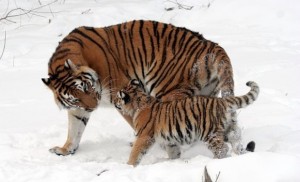 By portraying animals as unique creatures with qualities to be valued, Allison hopes to incite young readers through their parents and teachers to take action to help save endangered and threatened animals from extinction. “Many endangered species are declining at a rapid rate, and many others are facing extinction,” Witmer
By portraying animals as unique creatures with qualities to be valued, Allison hopes to incite young readers through their parents and teachers to take action to help save endangered and threatened animals from extinction. “Many endangered species are declining at a rapid rate, and many others are facing extinction,” Witmer 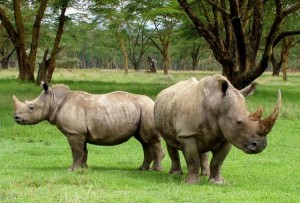 reports. “Between 1970 and 2006, the population of vertebrate species fell by one-third, including 50% of our closest relative species, primates, as a result of human activity.”
reports. “Between 1970 and 2006, the population of vertebrate species fell by one-third, including 50% of our closest relative species, primates, as a result of human activity.”
According to a study published earlier this year in the journal Nature, 41 percent of all amphibians on the planet now face extinction, while 26 percent 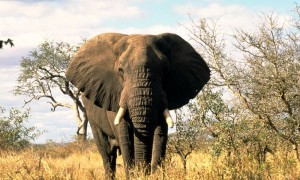 of mammal species and 13 percent of birds are similarly threatened. Unlike past mass extinction events that were supposedly caused by natural disasters or asteroid strikes (like the one that wiped out the dinosaurs some 65 million years ago), this one is driven mostly by human actions. “Habitat destruction, pollution or overfishing
of mammal species and 13 percent of birds are similarly threatened. Unlike past mass extinction events that were supposedly caused by natural disasters or asteroid strikes (like the one that wiped out the dinosaurs some 65 million years ago), this one is driven mostly by human actions. “Habitat destruction, pollution or overfishing 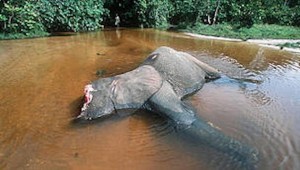 either kills off wild creatures and plants or leaves them badly weakened,” Derek Tittensor, a marine ecologist at the World Conservation Monitoring Centre in Cambridge, told The Guardian. “The trouble is that in coming decades, the additional threat of worsening climate change will become more and more pronounced and could then kill off these survivors.”
either kills off wild creatures and plants or leaves them badly weakened,” Derek Tittensor, a marine ecologist at the World Conservation Monitoring Centre in Cambridge, told The Guardian. “The trouble is that in coming decades, the additional threat of worsening climate change will become more and more pronounced and could then kill off these survivors.”
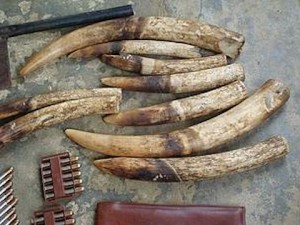 Among the most threatened species are the African elephant (whose numbers have dwindled from millions to less than 400,000 due largely to poaching for their ivory tusks), the northern white rhino (only five of which remain in the entire world and none in the wild), the Amur Leopard (whose numbers in the wild have dwindled to less than 30 adults), the 7-foot-long and 2,000 pound Leatherback Turtle, the Polar Bear (
Among the most threatened species are the African elephant (whose numbers have dwindled from millions to less than 400,000 due largely to poaching for their ivory tusks), the northern white rhino (only five of which remain in the entire world and none in the wild), the Amur Leopard (whose numbers in the wild have dwindled to less than 30 adults), the 7-foot-long and 2,000 pound Leatherback Turtle, the Polar Bear (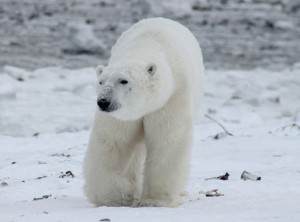 whose remaining population of 20,000 bears could disappear from the earth by 2100 if climate change continues at its current pace), Mountain Gorillas (whose numbers now total less than 900 worldwide), and Siberian Tigers (with less than 500 still in existence in the world today).
whose remaining population of 20,000 bears could disappear from the earth by 2100 if climate change continues at its current pace), Mountain Gorillas (whose numbers now total less than 900 worldwide), and Siberian Tigers (with less than 500 still in existence in the world today).
Lest one think that the problem is restricted to 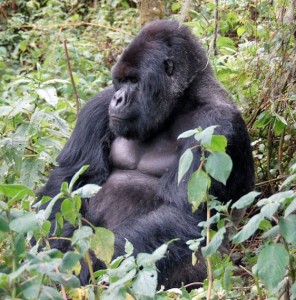 sub-Sahara Africa and the Arctic, the Florida panther once ranged throughout the southeastern United States but now survives in a tiny area of South Florida representing just 5 percent of its former range. It was listed as an endangered species in 1967 because of habitat destruction and fragmentation through urban sprawl. Large numbers of panthers died as the expanding network of roads connecting Florida’s rapidly growing human population spread throughout its range. As of 2011, there are only 100 to 120 panthers left.
sub-Sahara Africa and the Arctic, the Florida panther once ranged throughout the southeastern United States but now survives in a tiny area of South Florida representing just 5 percent of its former range. It was listed as an endangered species in 1967 because of habitat destruction and fragmentation through urban sprawl. Large numbers of panthers died as the expanding network of roads connecting Florida’s rapidly growing human population spread throughout its range. As of 2011, there are only 100 to 120 panthers left.
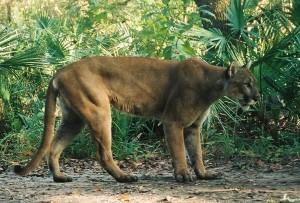 Of all the species that have populated Earth at some time over the past 3.5 billion years, more than 95 percent have vanished, and the number of wild animals on the planet has halved in just the past 40 years. Marine animal populations have also fallen by 40% overall, with turtles suffering in particular. The steep decline of animal, fish and bird numbers was calculated by analysing 10,000
Of all the species that have populated Earth at some time over the past 3.5 billion years, more than 95 percent have vanished, and the number of wild animals on the planet has halved in just the past 40 years. Marine animal populations have also fallen by 40% overall, with turtles suffering in particular. The steep decline of animal, fish and bird numbers was calculated by analysing 10,000 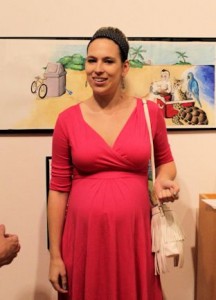 different populations, covering 3,000 species in total. This data was then, for the first time, used to create a representative “Living Planet Index” (LPI), reflecting the state of all 45,000 known vertebrates.
different populations, covering 3,000 species in total. This data was then, for the first time, used to create a representative “Living Planet Index” (LPI), reflecting the state of all 45,000 known vertebrates.
In all, Allison created 22 illustrations for the book. Each was rendered using a combination of acrylic paint, watercolors and colored pencils on Stonehenge watercolor paper. In developing the persona and attributes of each of the animals that Tito encounters during the course of the 32-page story, Allison made trips to zoos and exotic pet shops. Her own dog, Tito, served as muse for the lead in the tale. “Not an easy task since he doesn’t sit still for very long,” Allison quips.
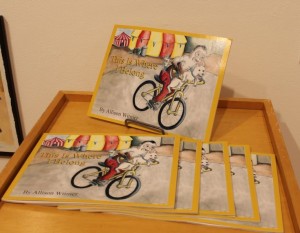 To make the book, Witmer first scanned and digitally uploaded the illustrations as PDF files to her printer using a program called InDesign. She used Photoshop to add text. After printing and collating each of the pages of the book, she then put the binder and cover in place.
To make the book, Witmer first scanned and digitally uploaded the illustrations as PDF files to her printer using a program called InDesign. She used Photoshop to add text. After printing and collating each of the pages of the book, she then put the binder and cover in place.
“Creating this book was a labor of love for me,” says Allison. “It combines my three favorite 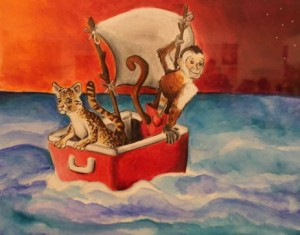 endeavors in life: making colorful, uplifting art; teaching children; and spreading the consciousness that each animal sharing our planet deserves to be treated fairly and with respect.”
endeavors in life: making colorful, uplifting art; teaching children; and spreading the consciousness that each animal sharing our planet deserves to be treated fairly and with respect.”
No word on whether any publishers or literary agents have expressed interest in taking This is Where I Belong nationwide or, with translation, to children around the globe.
The Senior Projects, Fall 2015 exhibition opening reception begins at 5 p.m., with each senior giving a 5-minute long oral presentation of their project and process beginning at 6.
________________________________________________________________________
FGCU art major Adam Snell uses red earthenware clay to make ceramics that reference life’s scars (12-02-15)
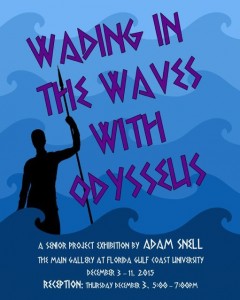 Senior Projects, Fall 2015 goes on view on Thursday, December 3. The exhibition contains work by eleven FGCU graduating seniors, including ceramicist Adam Snell.
Senior Projects, Fall 2015 goes on view on Thursday, December 3. The exhibition contains work by eleven FGCU graduating seniors, including ceramicist Adam Snell.
Snell fondly recalls the myriad stories that his parents read to him and his brother as they were growing up, but his favorite story of all time is The Odyssey. “I decided to pick out a number of [Odysseus’] adventures as the basis for a series of ceramic sculptures,” shares Snell in his Artist’s Statement. “The clay, as a medium, is a metaphor because you literally have to sculpt, shape and mold it. Working in clay allows me to reference life’s scars through the textural properties of the 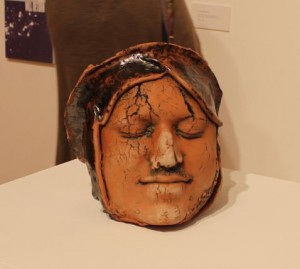 material.”
material.”
For his sculptures, Adam employed red earthenware clay, a natural substance found throughout the world. “I chose to leave the pieces rough and jagged because they are meant to be symbolic of life’s scars,” explains Snell, who used direct hand-building and carving methods to make each piece, as well as casting and mold-making for the faces and figurative shapes. Once the molds were bone dry, he then bisque fired them to 1728 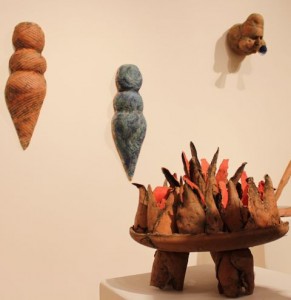 degrees Farenheit.
degrees Farenheit.
“Following the bisque, I decorated the surfaces with glazes and stains using a selection of mineral oxides and crawl glazes to emphasize the textured surfaces,” Adam continues. “It was important to have the textures be seen and accented because they are representations of the struggles that I have faced and how I conquered them.” With the glazes and stains applied, he then re-fired the sculptures to 1888 degrees to allow proper adhesion of the clay and chemical reactions for decorative purposes.
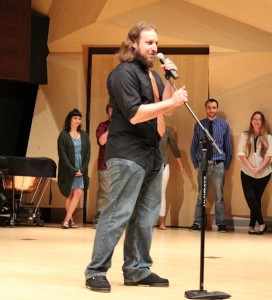 And just as the adventures that Odysseus endured during his travels hold deeper meanings, Snell’s metaphorical and richly symbolic ceramics attest to his conviction that no matter what challenges we face, the overall theme is overcoming life’s obstacles and having those individual lessons shape who you become. Or as the German philosopher Friedrich Nietzsche phrased it in Will to Power, “that which does not destroy me only serves to make me stronger.”
And just as the adventures that Odysseus endured during his travels hold deeper meanings, Snell’s metaphorical and richly symbolic ceramics attest to his conviction that no matter what challenges we face, the overall theme is overcoming life’s obstacles and having those individual lessons shape who you become. Or as the German philosopher Friedrich Nietzsche phrased it in Will to Power, “that which does not destroy me only serves to make me stronger.”
The Senior Projects, Fall 2015 exhibition opening reception begins at 5 p.m., with each senior giving a 5-minute long oral presentation of their project and process beginning at 6.
_____________________________________________________________
Jessica Neumann channels ‘Animal Instinct’ for senior art project (12-02-15)
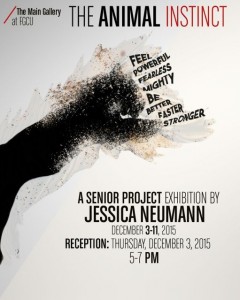 Senior Projects, Fall 2015 opens Thursday night in the art gallery at FGCU. It contains work by eleven graduating art majors, who are required to give a 5-minute oral introduction to their projects to family, friends and other guests.
Senior Projects, Fall 2015 opens Thursday night in the art gallery at FGCU. It contains work by eleven graduating art majors, who are required to give a 5-minute oral introduction to their projects to family, friends and other guests.
Jessica Neumann is a work-out beast. “Personal fitness has always been a lifestyle I enjoy,” she proclaims in her Artist’s Statement. “I believe in fitness built on strength, and striving to train beyond the limits of what I think my body can reach.” So it was only natural for Neumann to develop as her senior project an advertising campaign that revolves around a person’s inner animal for Around the Clock Fitness.
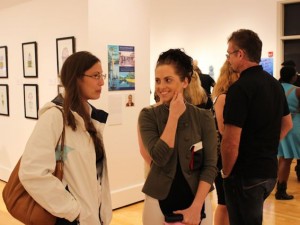 “I worked to create an image of what a person sees and feels when exercising and show the influence of their inner animal,” says Jessica of her organizing principle. Toward that end, she photographed models posing in different categories, such a weightlifting, cardio, yoga and plyometrics. In each case, she encouraged her muses to embrace their inner animal. To digitally enhance the link between human and animal,
“I worked to create an image of what a person sees and feels when exercising and show the influence of their inner animal,” says Jessica of her organizing principle. Toward that end, she photographed models posing in different categories, such a weightlifting, cardio, yoga and plyometrics. In each case, she encouraged her muses to embrace their inner animal. To digitally enhance the link between human and animal, 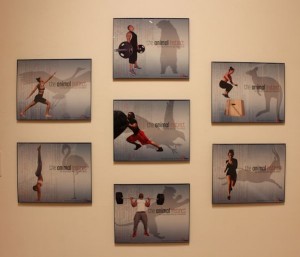 she cut out the background using Photoshop and placed each model against a blue-white gradient that served to emphasize the human body at work. “I then placed a silhouette of the animal they represent beside them,” Jessica explains. “I used text by placing it vertically behind the model, constructed in different sizes. This causes the viewer to dig deeper into what they are thinking by highlighting the attributes that are found in animals and using self-talk derived from their
she cut out the background using Photoshop and placed each model against a blue-white gradient that served to emphasize the human body at work. “I then placed a silhouette of the animal they represent beside them,” Jessica explains. “I used text by placing it vertically behind the model, constructed in different sizes. This causes the viewer to dig deeper into what they are thinking by highlighting the attributes that are found in animals and using self-talk derived from their 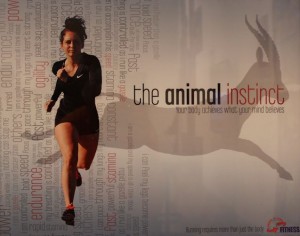 relationship with their animal.”
relationship with their animal.”
Neumann incorporated this artwork into a series of posters and a video, the combined effect of which is to incite people to tap into their animal instincts in order to supply motivation when, invariably, they contemplate abandoning their weight loss and other fitness goals because the progress they are making is so imperceptible as to be seemingly immeasurable.
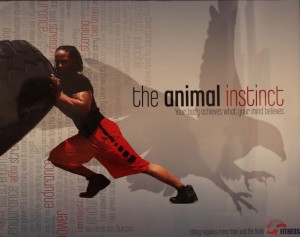 “Motivation is the key in achieving our goals when it comes to molding our bodies into what we want them to be,” Neumann sagely observes. “Digging deep within the core of human thinking is where the motivation forms. But humans are also animals, and when it comes to fitness, that inner animal needs to come out. Accessing the animal instinct can become the primary inspiration for growing into a better, faster and stronger person.”
“Motivation is the key in achieving our goals when it comes to molding our bodies into what we want them to be,” Neumann sagely observes. “Digging deep within the core of human thinking is where the motivation forms. But humans are also animals, and when it comes to fitness, that inner animal needs to come out. Accessing the animal instinct can become the primary inspiration for growing into a better, faster and stronger person.”
The Senior Projects, Fall 2015 exhibition opening reception begins at 5 p.m., with each senior giving a 5-minute long oral presentation of their project and process beginning at 6.
____________________________________________________________________________
FGCU art major takes viewers down path of horror film genre with senior art project (11-29-15)
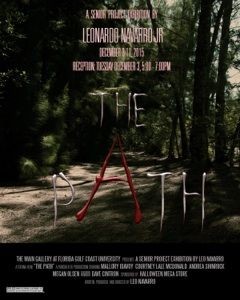 Through The Path, FGCU art major Leo Navarro, Jr. delves into the genre of the horror film. Navarro will premiere the film on Thursday evening when the Senior Projects, Fall 2015 exhibition opens in the main art gallery at Florida Gulf Coast University.
Through The Path, FGCU art major Leo Navarro, Jr. delves into the genre of the horror film. Navarro will premiere the film on Thursday evening when the Senior Projects, Fall 2015 exhibition opens in the main art gallery at Florida Gulf Coast University.
Navarro spent over 72 hours behind the lens of a Canon G40 camcorder to shoot the film and another 150 hours sitting at his computer editing the movie. “I shot the film at 6 p.m. in the evening in order to keep the natural light low and the continuity the same,” Navarro explains in his Artist’s Statement accompanying the film. “Each shot was filmed from 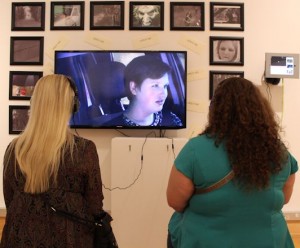 at least three different angles at least three different times. The only shots not utilizing the Canon G40 were the aerial shots.” He used a drone for those scenes. The entire movie was shot near a stone quarry in Lehigh Acres that Navarro had used previously.
at least three different angles at least three different times. The only shots not utilizing the Canon G40 were the aerial shots.” He used a drone for those scenes. The entire movie was shot near a stone quarry in Lehigh Acres that Navarro had used previously.
As is customary within the film industry, Navarro created a storyboard to govern the action but shot most of the film out of sequence and then 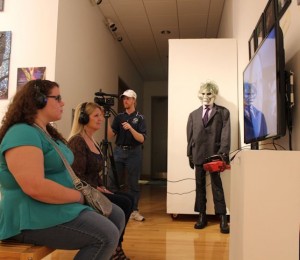 assembled and edited the resulting snippets and fragments over the course of three months using the Adobe Master Suites Collection.
assembled and edited the resulting snippets and fragments over the course of three months using the Adobe Master Suites Collection.
“I have been making films for over three years now, including writing, producing and directing the picture, as well as editing, costume design and special effects make-up,” Navarro divulges. He has filmed two documentaries for FGCU, a short horror film for his Digital Media class entitled 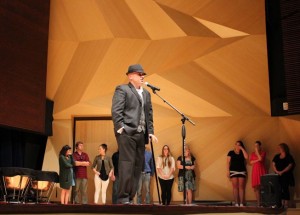 After School and has been the Special Effects creator and designer on several independent films shot locally in Southwest Florida. “With The Path, I am showcasing my abilities as a storyteller, film maker, and special effects artist,” Navarro preens. “The Path follows a dynamic revenge/mortality narrative in which the main character finds herself isolated and not knowing why awful things are
After School and has been the Special Effects creator and designer on several independent films shot locally in Southwest Florida. “With The Path, I am showcasing my abilities as a storyteller, film maker, and special effects artist,” Navarro preens. “The Path follows a dynamic revenge/mortality narrative in which the main character finds herself isolated and not knowing why awful things are 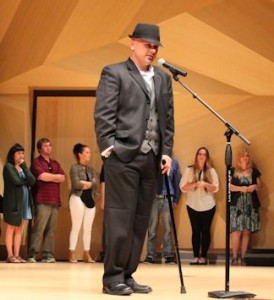 happening to her. These traditional elements connect my film to the horror genre.”
happening to her. These traditional elements connect my film to the horror genre.”
Navarro first became intrigued with the genre when he watched Steven Spielberg’s Poltergeist at the tender age of 8. In spite of his youth, he quickly taught himself to visually break down movies frame by frame. Where older viewers might list Dracula, Frankenstein’s monster and the Creature from the Black Lagoon as iconic horror movie characters, Navarro’s favs were Jason Voorhees, Freddie Kruger and Michael Myers. As for the appeal of horror films, Navarro postulates that 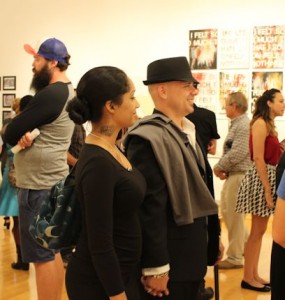 they remind us all of our own mortality. “Audience members choose to go along with the movie characters to that dangerous place in the film because they want to know what it feels like to experience that situation without really being there.”
they remind us all of our own mortality. “Audience members choose to go along with the movie characters to that dangerous place in the film because they want to know what it feels like to experience that situation without really being there.”
Do you dare follow Leo Navarro down The Path?
The Senior Projects, Fall 2015 exhibition opening reception begins at 5 p.m., with each senior giving a 5-minute long oral presentation of their project and process beginning at 6. Speaking of fear and trembling ….
__________________________________________________________________
Senior April Rodmyre recycles burlap bags from around the world to create mixed media abstracts en plein air (11-29-15)
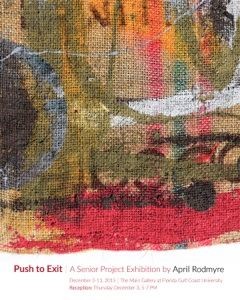 Senior Projects, Fall 2015 opens December 3 with a reception at 5 followed by 5-minute oral presentations by each art major with work in the exhibition. April Rodmyre is one of eleven graduating seniors with work on display in the show.
Senior Projects, Fall 2015 opens December 3 with a reception at 5 followed by 5-minute oral presentations by each art major with work in the exhibition. April Rodmyre is one of eleven graduating seniors with work on display in the show.
Rodmyre has created a series of mixed media paintings that reflect on order and rhythm, separation and disconnection and the diversity of human experience. But the first thing viewers will notice as they approach her abstracts is the highly textured supports on which they are painted.
“The genesis for this work was an encounter with … the burlap 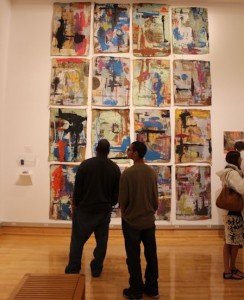 bags used to ship unroasted coffee beans from across the globe to a Fort Myers, Florida roasting plant,” Rodmyre explains in her Artist’s Statement. “Each 150-pound gunny sack is unique in thread thickness, natural shades and shape. I was immediately seduced by the texture of the coarse jute fibers and by the long journey these materials had taken, only to be discarded once their purpose was complete.”
bags used to ship unroasted coffee beans from across the globe to a Fort Myers, Florida roasting plant,” Rodmyre explains in her Artist’s Statement. “Each 150-pound gunny sack is unique in thread thickness, natural shades and shape. I was immediately seduced by the texture of the coarse jute fibers and by the long journey these materials had taken, only to be discarded once their purpose was complete.”
April is not the first artist to be seduced by the textural qualities of burlap. During their time together in Arles, van Gogh and Gauguin painted side by side on burlap supports that accentuated the textural qualities, impasto and 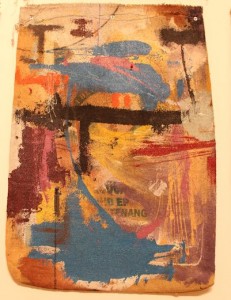 dramatic brushwork that characterized their late career post-Impressionist works. But Rodmyre was intrigued by the prospect of painting on burlap for another reason.
dramatic brushwork that characterized their late career post-Impressionist works. But Rodmyre was intrigued by the prospect of painting on burlap for another reason.
“During my design career, I’ve spent several thousand hours analyzing digital detail and spatial relationships at the pixel level,” remarks Rodmyre, who considers herself first and foremost a graphic artist. “Making this project required me to exit from my normal technology-centered routines and focus on the material directly in front of me.”
She also escaped the confines of the studio, rendering each 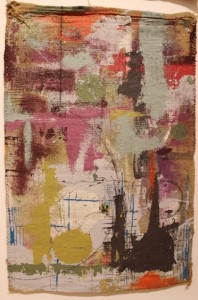 painting outdoors, in the grass and under the shade of nearby trees. She allowed the wind to blow small pieces of leaves, seeds and flowers onto the paint, where they mix companionably with her acrylics and a few unroasted coffee beans that insinuated themselves within the jute fibers of the burlap. “I responded to the unique burlap threads primarily using acrylic paint, but also charcoal, pen, tapes and toner transfers,” April expounds. “Painting the layers flat on the ground is part calculated and part intuitive, a tactile discovery process.”
painting outdoors, in the grass and under the shade of nearby trees. She allowed the wind to blow small pieces of leaves, seeds and flowers onto the paint, where they mix companionably with her acrylics and a few unroasted coffee beans that insinuated themselves within the jute fibers of the burlap. “I responded to the unique burlap threads primarily using acrylic paint, but also charcoal, pen, tapes and toner transfers,” April expounds. “Painting the layers flat on the ground is part calculated and part intuitive, a tactile discovery process.”
Rodmyre’s choice of support, decision to paint large scale, and resolve to eschew both studio and the crutch of the too-familiar microtechnology of graphic design served another purpose. “In spite of 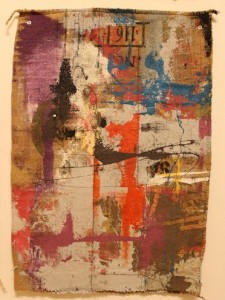 technology designed to ‘keep us more connected,’ there is a contemporary phenomenon of increased separation, whether social, physical, spiritual or emotional,” April observes. “This includes a deepening disconnection with even the most intimate items we consume daily.”
technology designed to ‘keep us more connected,’ there is a contemporary phenomenon of increased separation, whether social, physical, spiritual or emotional,” April observes. “This includes a deepening disconnection with even the most intimate items we consume daily.”
The paintings in Push to Exit represent Rodmyre’s personal victory over shackles of social media and nanotechnology. And the artist would like her viewers to taste the nectar of her sweet success. “I invite viewers to experience the exhibition separated from their own devices, as well as to interactively contribute to the artwork by pushing in their own exit points.”
_________________________________________________________
FGCU art grad Richard Crum’s senior project takes him into the realm of Area 51 (11-28-15)
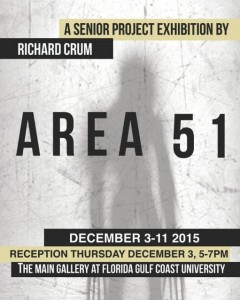 One of the benefits of attending an exhibition like FGCU’s Senior Projects, Fall 2015 is gaining exposure to a wide array of artistic disciplines. In addition to painting and sculpture, this semester’s senior show includes an illustrated children’s book, a comic book, an advertising campaign for a fitness center, a horror film and video game-making.
One of the benefits of attending an exhibition like FGCU’s Senior Projects, Fall 2015 is gaining exposure to a wide array of artistic disciplines. In addition to painting and sculpture, this semester’s senior show includes an illustrated children’s book, a comic book, an advertising campaign for a fitness center, a horror film and video game-making.
Like many college students, Richard Crum grew up playing video games. But after years of merely being entertained as a player, Crum decided to create his own video game, which he calls Area 51.
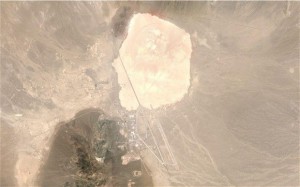 “Area 51 is the biggest conspiracy theory out there,” Crum declares. “Over 45% of the United States population believes in it according to the Huffington Post. My video game reflects on this idea. You play as a character that does not believe in conspiracy theories, but once inside, you find out things are not as logical as you thought and it becomes a matter of escaping and surviving.”
“Area 51 is the biggest conspiracy theory out there,” Crum declares. “Over 45% of the United States population believes in it according to the Huffington Post. My video game reflects on this idea. You play as a character that does not believe in conspiracy theories, but once inside, you find out things are not as logical as you thought and it becomes a matter of escaping and surviving.”
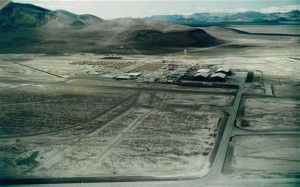 Crum professes to be noncommittal on the subject of whether Area 51 is real or rumor. “I have spent summers in … New Mexico, Colorado and Nevada and have seen for myself multiple government restricted areas in the middle of nowhere,” says Crum. “No one knows what is behind those gates; it’s a mystery and always will be.” But that mystery created an opportunity for Crum, which he took advantage of by using a video game development platform called Unity.
Crum professes to be noncommittal on the subject of whether Area 51 is real or rumor. “I have spent summers in … New Mexico, Colorado and Nevada and have seen for myself multiple government restricted areas in the middle of nowhere,” says Crum. “No one knows what is behind those gates; it’s a mystery and always will be.” But that mystery created an opportunity for Crum, which he took advantage of by using a video game development platform called Unity.
According to Crum’s Artist’s Statement for Area 51, the process is time-consuming and laborious. Java script had to be written for every character, object and action taking place within the environment of the game, with Photoshop being employed to design the look and feel of the game. You can judge for yourself how well Crum did. Area 51 will not only be on display, it will be up and running during the opening of Senior Projects, Fall 2015 on Thursday, December 3. See above for more information as well as summaries of the other projects included in the exhibition.
N.B.: Area 51 has become the holy grail for conspiracy theorists, with UFOlogists positing that the Pentagon reverse engineers flying saucers and keeps extraterrestrial beings stored in freezers. In 2013, the CIA acknowledged its exact location in Nevada, near Groom Lake, in a series of documents released as part of a Freedom of Information request. While NASA Administrator Major Charles Bolden has also recently confirmed the existence of Area 51, he emphatically denies that the government is storing aliens or extra-terrestrial aircraft at the site.
_____________________________________________________________________________
Pamela Davis paintings and sketches highlight beauty and conservation of Peace River (11-27-15)
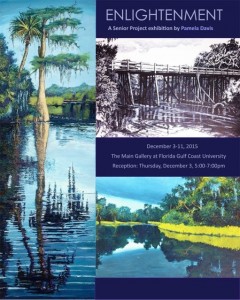 The Senior Projects, Fall 2015 exhibition opens in the main gallery at Florida Gulf Coast University on Thursday, December 3. One of the art majors taking part in the show is Pamela Davis.
The Senior Projects, Fall 2015 exhibition opens in the main gallery at Florida Gulf Coast University on Thursday, December 3. One of the art majors taking part in the show is Pamela Davis.
Davis titles her project Enlightment. It features a series of mixed media paintings and black-and-white sketches of the Peace River.
“When I was a young person, the Peace River was the first place I chose to paint outdoors after a positive experience during a lesson with Robert Butler, one of the original Highwaymen who painted the Florida landscape,” recounts Davis in her Artist’s Statement. So enamored of the river is Davis that she helped develop and promote the DeSoto County Arts and Humanities Council’s “Art of the River Competition,” which annually celebrates the beauty of the Peace River.
Davis’ process began with a photo session on the river. Back in the studio, she used the images as reference material for ink sketches on paper which, in turn, served as rough drafts for more elaborate studies in acrylic and modeling paste on Masonite supports. From these, she crafted a large scale relief painting of Arwin Lake with wire, recycled homework and paper clay on panel and six scenes on wood panels that she painted with modeling paste and acrylics to create highly textured surfaces.
There is an historical aspect associated with the exhibit, which contains a total of seven paintings and ten black and white sketches – seventeen being how old Davis was when she first started painting on the river. “In the late 1800s, Fort Ogden, Florida was a major hub near the county seat of Tater Hill Bluff,” Davis notes. “It was a thriving community; the new doctor had his office down river from a bustling sawmill that produced railroad ties.” In fact, publisher Stafford Cleveland was bound for Fort Ogden in 1884 to establish a newspaper serving the up-and-coming town, but was shanghaied to Fort Myers by the captain of the schooner that brought him down the coast from Cedar Keys. Even though Fort Ogden didn’t get the paper, it got rail service nearly twenty years before rival Fort Myers and from “1925, the Tampa Southern Railroad traveled down the Fort Ogden extension to deliver goods and passengers until, in the mid-1970s, the train trestles caught on fire and the railroad was never used again.”
The fire turned out to be a stroke of good fortune for the fauna and flora that make their habitat in and along the river banks. “After nearly 100 years of the river’s occupation and exploitation, the passageways were rerouted and the natural environment quickly returned to its former beauty.” Today, this section of the river and its nearby tributaries are a popular fishing, camping and swimming hole, and it is this portion of the river, in particular, that serves as inspiration for Davis’ senior project.
Davis does have an overarching purpose behind her work. “The intention of the work in this exhibition is to invite you to see this beauty and encourage you to experience the real thing, learn more about your environment, and understand the importance of environmental conservation,” Davis admits. If the artist has her way, everyone visiting the exhibition will take away a sense of her “great respect and deep emotional connection with the past and present of this majestic river” and the ongoing need to support the conservation of not only this waterway, but every natural body of water, whether located in Florida or elsewhere in the world.
_______________________________________________________________
Art major Alyssa Bates delves into world of PTSD with senior project (11-27-15)
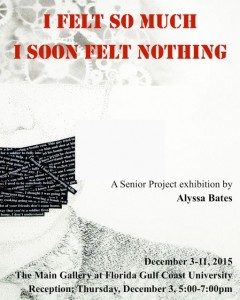 The Senior Projects, Fall 2015 exhibition opens in the main gallery at Florida Gulf Coast University on Thursday, December 3. One of the art majors taking part in the show is Alyssa Bates.
The Senior Projects, Fall 2015 exhibition opens in the main gallery at Florida Gulf Coast University on Thursday, December 3. One of the art majors taking part in the show is Alyssa Bates.
Some artists use their work to express their connection with the natural world. Others seek to explore new ways of seeing or thinking about their environment. In I Felt So Much I Soon Felt Nothing, Alyssa Bates uses art to sort through her feelings about, and come to terms with, a complex psychological problem that has plagued her since childhood, namely PTSD or Post-Traumatic Stress Disorder.
Bates does not suffer from PTSD herself. But her mom has ever since Alyssa can remember. “My mother was diagnosed with Post Traumatic Stress Disorider when I was a child,” Alyssa writes in her Artist’s Statement. “She did not bring up her condition very often; if she talked about her life, it meant she had to relive the darkest moments. Over time I normalized my mother’s symptoms as just a part of who she was, a part of her personality.”
But with her husband now preparing to join the Navy, Bates is forced to confront the new and real possibility that he could experience events that subject him to this condition, as well. “Within these works, I am exploring the emotions and coping methods of those battling with PTSD,” states Bates. “The creation of this work is fueled by this real desire to understand this disorder, my mother and the military life on a deeper level.”
As her mother’s case illustrates, anyone can experience PTSD. Roughly 70% of adults in the United States or 223 million people will experience a traumatic event sometime during their lives. Up to 20% of these folks go on to develop PTSD. That means that over 44 million Americans have experienced, or are struggling with, PTSD. According to the U.S. Department of Veteran Affairs’ National Center for PTSD, about 7-8% of the population or 24.4 million adults will have PTSD at some point in their lives, which is equal to the population of the State of Texas. Roughly 10% of women develop PTSD sometime in their lives compared with about 4% of men.
“There could be someone standing right next to you suffering, and you wouldn’t even know it,” Alyssa observes. “When traumatic events do not end, over time the mind is unable to cope. The person feels trapped within themselves, reliving the trauma over and over. These invisible wounds ensnare the individual in a battle that never ends.”
In doing research for her project, Bates discovered that people afflicted with PTSD frequently report difficulty in talking about the condition. She used this as the springboard for her artwork, using their phrases and stories both physically within the work and as inspiration. “Texture and layers create a visual analog for this condition,” Bates points out. “I am using acrylic paint, crackle paste, tape, ink and charcoal within my pieces. These layers are meant to represent being overburdened with trauma and being unable to escape from it.”
Powerfully evocative and viscerally poignant, I Felt So Much I Soon Felt Nothing may not only help Bates deal with the condition she has experienced from the outside for most of her life, it has something to say to everyone who suffers from PTSD or who lives, loves or works with someone who does.














 Tom Hall is both an amateur artist and aspiring novelist who writes art quest thrillers. He is in the final stages of completing his debut novel titled "Art Detective," a story that fictionalizes the discovery of the fabled billion-dollar Impressionist collection of Parisian art dealer Josse Bernheim-Jeune, thought by many to have perished during World War II when the collection's hiding place, Castle de Rastignac in southern France, was destroyed by the Wehrmacht in reprisal for attacks made by members of the Resistance operating in the area. A former tax attorney, Tom holds a bachelor's degree as well as both a juris doctorate and masters of laws in taxation from the University of Florida. Tom lives in Estero, Florida with his fiancee, Connie, and their four cats.
Tom Hall is both an amateur artist and aspiring novelist who writes art quest thrillers. He is in the final stages of completing his debut novel titled "Art Detective," a story that fictionalizes the discovery of the fabled billion-dollar Impressionist collection of Parisian art dealer Josse Bernheim-Jeune, thought by many to have perished during World War II when the collection's hiding place, Castle de Rastignac in southern France, was destroyed by the Wehrmacht in reprisal for attacks made by members of the Resistance operating in the area. A former tax attorney, Tom holds a bachelor's degree as well as both a juris doctorate and masters of laws in taxation from the University of Florida. Tom lives in Estero, Florida with his fiancee, Connie, and their four cats.